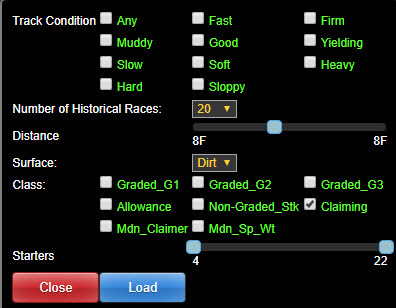|
The key to winning handicapping is to have the best stats available to you at all times. When looking at similar races from the past its always best to compare apples to apples! We have made a simple change to BirdDog that gives you much more control over the stats you see for any race. When you have the Factor Statistics widget open in BirdDog you will see a new gear icon. Clicking that icon brings up a menu that allows you to filter information about the races you want included in your stats.
 After clicking that icon you will see a menu like this:
 TRACK CONDITION: This allows you to select past races that were run on the same kind of track that you are handicapping today. If you only want to include Fast races then you would select that option. If the track is muddy or sloppy you would select those options and the races used in the stats would be restricted to past races like this that were run over a sloppy or muddy track. When a race comes off the turf, you would select the new surface as Dirt and then most likely change the track condition to Muddy or Sloppy (or both to include more races). NUMBER OF HISTORICAL RACES: This gives you control over how many races are used to compile the statistics. You can look at the last 200 similar races, but sometimes recency is more important. In some race types you will only find a few races no matter how many you are looking for. Grade 1 races, and odd distances may not have more than 4 or 5 similar races over the life of our database. Common races like 6f dirt claiming races will return the maximum of 200. DISTANCE: By default all of the settings reflect the information about the current race you are handicapping, and the distance will be set to exactly what today's race is. Sometimes when a race comes off the turf, the distance is also changed, so you would want to make that change here if that occurs. If you are getting a small result set for an uncommon distance like 11 furlongs, you may want to expand your results by including 10f -12f races. SURFACE: In the event that a race is switched from Turf to Dirt you would make that change here. You would never want to switch to turf for a dirt race! CLASS: Again, if you are finding very few similar race types for a race you are handicapping you may want to broaden the class range. For a Graded race, you may want to expand your results to include G1, G2 and G3 races. You could also include non-graded stakes... STARTERS: Sometimes you will see a significant difference in the types of stats for a race based on the number of starters. If there is a small field (6 or less horses) you may want to only look at other races with small fields. The same would hold true for races with large fields (10 or more horses). Different pace factors can become more or less important based on the size of the field you are handicapping. |

